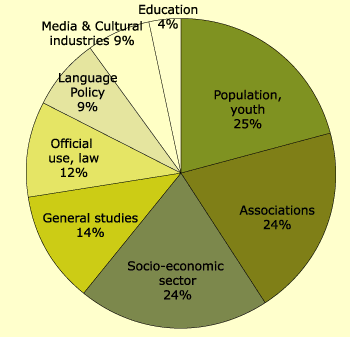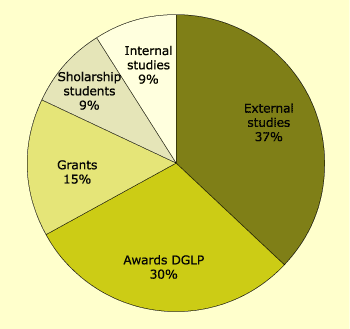 |
Summary0.
Introduction
1. Description of the studies
2.
Explanation of the studies
2.1
General studies
2.2
Joint studies with other language planning bodies of
2.3
Specific or sectorial studies
2.4
Studies of students in scholarship
2.5
Advice to other language planning bodies
2.6
Awards and grants
3. Dissemination of results
4.
Methodology
5.
Applicability of research in language policy
6.
Conclusions
7.
Bibliography
7.1
Printed bibliography
7.2
Electronic bibliography
0. Introduction
The first
sociolinguistic research promoted by the DGLP was carried out shortly after its
foundation. The need to obtain information on the linguistic attitudes of the population
led to the studies that later formed the basis for the learning material "Digui,
digui…". The latter made use of a sociolinguistic survey on perspectives of use,
attitudes and needs of the adult population of the area of Barcelona (in its widest
sense). The main results of this survey were published in 1986]. The complete
research activities of the DGLP between 1982 and 1993 have been summarized by Jordi Bañeres i Joan Maria Romaní
(1994). In that paper, the authors pointed out that:
"…
Many of these studies are of an excellent quality –most of them were carried out by
the best companies specialized in public opinion research– but are not very well
known by the scientific community. To reverse this state of
affairs is precisely the aim of this paper, i.e. to bring to light things that have
remained hidden… We are convinced these studies not only must be used as consultation
material by the Administration but have also a high documental and scientific value as a
reflection of the evolution of the Catalan sociolinguistic situation."
In my paper,
with the same commitment to spreading knowledge of the studies that have been carried out,
what areas have been surveyed and which methodology has been used, I am going to review
the most relevant studies and surveys carried out from 1994 up to now. It would be
impossible to describe all the studies since the DGLP has been working on more than 80 and
to review them all would produce far too long an article.
1. Description of the studies
Due to the
tasks typical of the DGLP, the vast majority of these studies deal with the topics stated
below:
Sociolinguistics
(especially regarding the Catalan language and its situation in different sectorial and
geographical domains).
Language
policy and planning.
Education
and didactics, both concerning Catalan for Catalan or non-Catalan speakers and general
theories about teaching methods for any language.
Language law
refering both to individual and collective rights.
Linguistic
anthropology, via studies of different linguistic communities, plurilingualism and
multiculturalism.
Other topics
dealing with the Catalan language.
The
proportion of studies according to ttopic is shown in figure 1:
Figure 1.
Percentages of studies by topics

This figure
shows that half of the research covers only two domains, i.e. the socio-economic sector
(24%) –a domain to which much effort was devoted throughout the period- and the
population sector (25%), both general and by particular age groups. There are few studies
on the education domain insofar as this area is competence of the Ministry of Education
which carries out or promotes studies according to its own needs. On the other hand, it
has to be made clear that the studies are of various different kinds:
General or
macro studies, with information about the population as a whole, as for example the works
analyzing the linguistic data provided by censuses or surveys based on representative
samples of the adult population.
Specific
studies or studies refering to a particular sector of the population, city or town, or to
language use in a specific domain such as the labelling of shops or in petrol stations.
-
Studies
granted to students or research studies entered forto the prizes
awarded by the DGLP (for example the Antoni M. Badia i Margarit
Award for empirical sociolinguistic research or the John McDowell
Award for innovation and research in the field of English teaching
or teaching of Catalan as first or second language). In view
of the specific subjects of this publication, I will not review
here the works refering to teaching methods, a topic already
studied in detail in different issues of Noves
SL and Llengua
i Ús.
Studies
carried out within the framework of scholarships granted since 1996 to students in
Political Science and Sociology at the Autonomous University of Barcelona.
Figure 2 shows
the proportions of studies according to their origin:
Figure 2.
Origin of studies

The main bulk
of the research is made up of external studies (more than one-third) and awards given by
the DGLP. Over the next several years, the proportion made up by this kind of study will
decrease given that the awards will be changed and from next year onwards they will be
awarded jointly with the Institut d’Estudis Catalans (IEC) [Institute of
Catalan Studies].
2. Explanation of
the studies
As stated
above, limits of space prevent us in this article from providing detailed information
concerning every study or piece of research reviewed, nor would that be appropriate. For
those interested in further details, click here
(PDF 86 k) gives information about the objectives, methodology and data gathering
processes of these studies. The bibliography also lists the books and articles arising
from the studies.
2.1 General studies
In this
section I should stress the relevance of the following studies:
The two
studies carried out from the data of the 1991 and 1996 censuses, the former, coordinated
by Modest Reixach (Reixach, 1997) provided an analysis of the census of the three
Catalan-speaking Spanish territories while the latter, coordinated by Fc. Xavier Vila
(Vila, 2000) focused only on the data of the Enquesta oficial de població de Catalunya
of 1996, carried out to obtain, among others, data on linguistic competence and forced
mobility, as these items could not be included in the municipal censuses. In this case and
for the first time, a chapter was devoted to knowledge of Occitan in the Aran Valley in
north west Catalonia. These two studies give continuity to the series of studies of the
1981 and 1986 linguistic censuses.
Several
surveys adult population samples undertaken with different objectives:
a) To
design and to elaborate the INUSCAT (INdex of USe of CATalan), a double indicator
containing on the one hand an objective value made up of different statistical sources and
on the other, a subjective value, obtained by means of a survey. Three studies were done:
Inuscat 1994. Estudi subjectiu. La parla de la gent. Ús del català i producció cultural
(J. Aragay and J. Sabaté); Inuscat 1995: Estudi subjectiu i Estudi objectiu: El món
socioeconòmic i l'Administració (J. Aragay, J. Sabaté and R. Mur); and Inuscat 1996:
Estudi subjectiu. Estudi objectiu/subjectiu: La societat civil catalana i l'ús del
català (J. Aragay and R. Mur).
b) To learn
about the interpersonal uses of the adult population, either within the family or at work,
using a representative sample of 3,323 people aged 15 and over. This survey was carried
out by telephone in 1997 and was conceived as a study parallel to the 1996 census in that
it completed the data regarding knowledge with data on actual language use. [This study is
further quoted as DYM 97].
c) To evaluate
the level of approval of movies in Catalan by the adult population of Catalonia. This
survey was carried out by telephone in 1997 with a representative sample of 1,707 people
aged 15 and over, and included both cinema goers and non-cinema goers.
d) To learn
about the opinion citizens had regarding the language policy of the Catalan government and
the application of Law 1/1998 on Language Policy one year after it had been passed.
|


